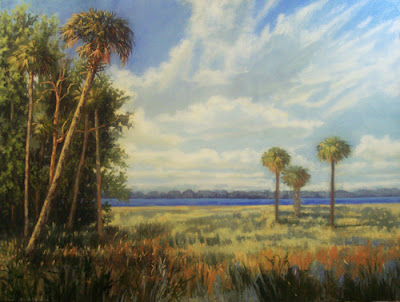Art Notes Blog HERE
Painters Tip:

I want to dicuss atmospheric or aerial perspective, using the above painting I just completed. It is a good example I think.
Atmospheric perspective is an important aspect of landscape painting because it expresses spatial depth in your painting. Think of your painting as having three major planes, foreground, middleground and background. As objects diminish in the distance, their tones shapes and colors become more and more muted because there are minute particles of dust and other objects in the air between your eyes and the objects. That is why a landscape painting with all hard crisp detail looks amateurish. The painter is not taking atmospheric perspective into consideration.
Making decisions about what to subdue in color and how to push back objects for the viewer can be complicated and difficult. In this painting, I felt that I wanted the distant palms to be a balance for the strong, powerful values in the foreground. By giving fairly crisp detail to the foreground tree mass, I automatically set the scene for softer distant objects.
Early in the painting, I grayed down the three palms on the right too much. The depth change was too strong to read well. I came back in, giving the distant palms a bit more color and detail but kept them very soft. If you look closely, you will see that the three palms diminish in detail and color from the tallest, to the middle and finally to the back palm. It is not much but there is some difference in the three. The star of my production is the large palm which leans into the picture plane pulling the viewer into the scene. That powerful diagonal which is repeated in the cloud mass offsets the vertical and horizontal elements, creating interest.
I don't think the painting would have been nearly as effective without the strong sense of depth created by the atmospheric perspective. If I had given equal importance to all of the elements it would have been lacking in drama and intrigue.
My advice is that you must consider atmospheric elements carefully in certain compositions. Have a clear plan about the three planes in a painting, foreground,middleground and background. Deciding where you want the focus to be will help you overcome the habit and tendancy to make all areas of the painting equally important.








